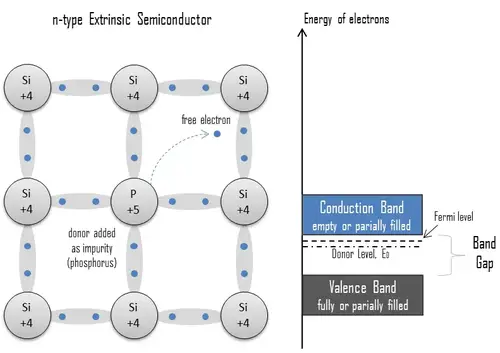Semiconductors
In general, semiconductors are inorganic or organic materials that can control their conduction depending on chemical structure, temperature, illumination, and the presence of dopants. The name semiconductor comes from the fact that these materials have electrical conductivity between a metal, like copper, gold, etc., and an insulator, like glass. They have an energy gap of less than 4eV (about 1eV). In solid-state physics, this energy gap or band gap is an energy range between the valence band and conduction band where electron states are forbidden. In contrast to conductors, semiconductors’ electrons must obtain energy (e.g., from ionizing radiation) to cross the band gap and reach the conduction band. The properties of semiconductors are determined by the energy gap between valence and conduction bands.
Types of Semiconductors
Semiconductors can be classified into two basic types based on their electronic properties:
- Intrinsic Semiconductors: These are pure semiconductors that are made up of a single element (e.g., Silicon, Germanium) and have no intentional doping with impurities. Intrinsic semiconductors have a specific number of electrons in their valence band and conduction band. They conduct electricity when they are heated, and some electrons gain sufficient energy to break free from their bonds and become free electrons in the conduction band.
- Extrinsic Semiconductors: These are impure semiconductors that are intentionally doped with impurities to change their electronic properties. Extrinsic semiconductors can be further classified into two types:
- p-type semiconductors: In p-type semiconductors, impurity atoms such as boron are introduced into the semiconductor material. These impurities have fewer valence electrons than the semiconductor material, which results in “holes” (absence of electrons) being created in the valence band. These holes can conduct current like positive charge carriers, which gives the material its p-type designation.
- n-type semiconductors: In n-type semiconductors, impurity atoms such as phosphorus are introduced into the semiconductor material. These impurities have more valence electrons than the semiconductor material, which creates excess electrons in the conduction band. These excess electrons can conduct current like negative charge carriers, which gives the material its n-type designation.
Here is a table with 3 intrinsic semiconductors and 2 p-type and n-type semiconductors, along with 4 key properties:
able with 3 intrinsic semiconductors and 2 p-type and n-type semiconductors, along with 4 key properties:
| Semiconductor | Type | Band Gap (eV) | Electron Mobility (cm²/Vs) | Hole Mobility (cm²/Vs) | Thermal Conductivity (W/mK) |
|---|---|---|---|---|---|
| Silicon (Si) | Intrinsic | 1.12 | 1500 | 450 | 150 |
| Germanium (Ge) | Intrinsic | 0.67 | 3900 | 1900 | 60 |
| Gallium Arsenide (GaAs) | Intrinsic | 1.43 | 8500 | 400 | 46 |
| Boron-doped Silicon (p-Si) | p-type | 1.12 | 1500 | 1800 | 150 |
| Phosphorus-doped Silicon (n-Si) | n-type | 1.12 | 1500 | 4500 | 150 |
| Aluminum-doped Gallium Arsenide (p-GaAs) | p-type | 1.43 | 8500 | 200 | 46 |
| Silicon-doped Gallium Arsenide (n-GaAs) | n-type | 1.43 | 8500 | 800 | 46 |
n-type Semiconductors
An extrinsic semiconductor doped with electron donor atoms is called an n-type semiconductor because most charge carriers in the crystal are negative electrons. Since silicon is a tetravalent element, the normal crystal structure contains 4 covalent bonds from four valence electrons. The most common dopants in silicon are group III and V elements. Group V elements (pentavalent) have five valence electrons, allowing them to act as donors. That means adding these pentavalent impurities such as arsenic, antimony, or phosphorus contributes to free electrons, greatly increasing the conductivity of the intrinsic semiconductor. For example, a silicon crystal doped with boron (group III) creates a p-type semiconductor, whereas a crystal doped with phosphorus (group V) results in an n-type semiconductor.
The conduction electrons are completely dominated by the number of donor electrons. Therefore:
The total number of conduction electrons is approximately equal to the number of donor sites, n≈ND.
The charge neutrality of semiconductor material is maintained because excited donor sites balance the conduction electrons. The net result is that the number of conduction electrons increases while the number of holes is reduced. The imbalance of the carrier concentration in the respective bands is expressed by the different absolute number of electrons and holes. Electrons are majority carriers, while holes are minority carriers in n-type material.


